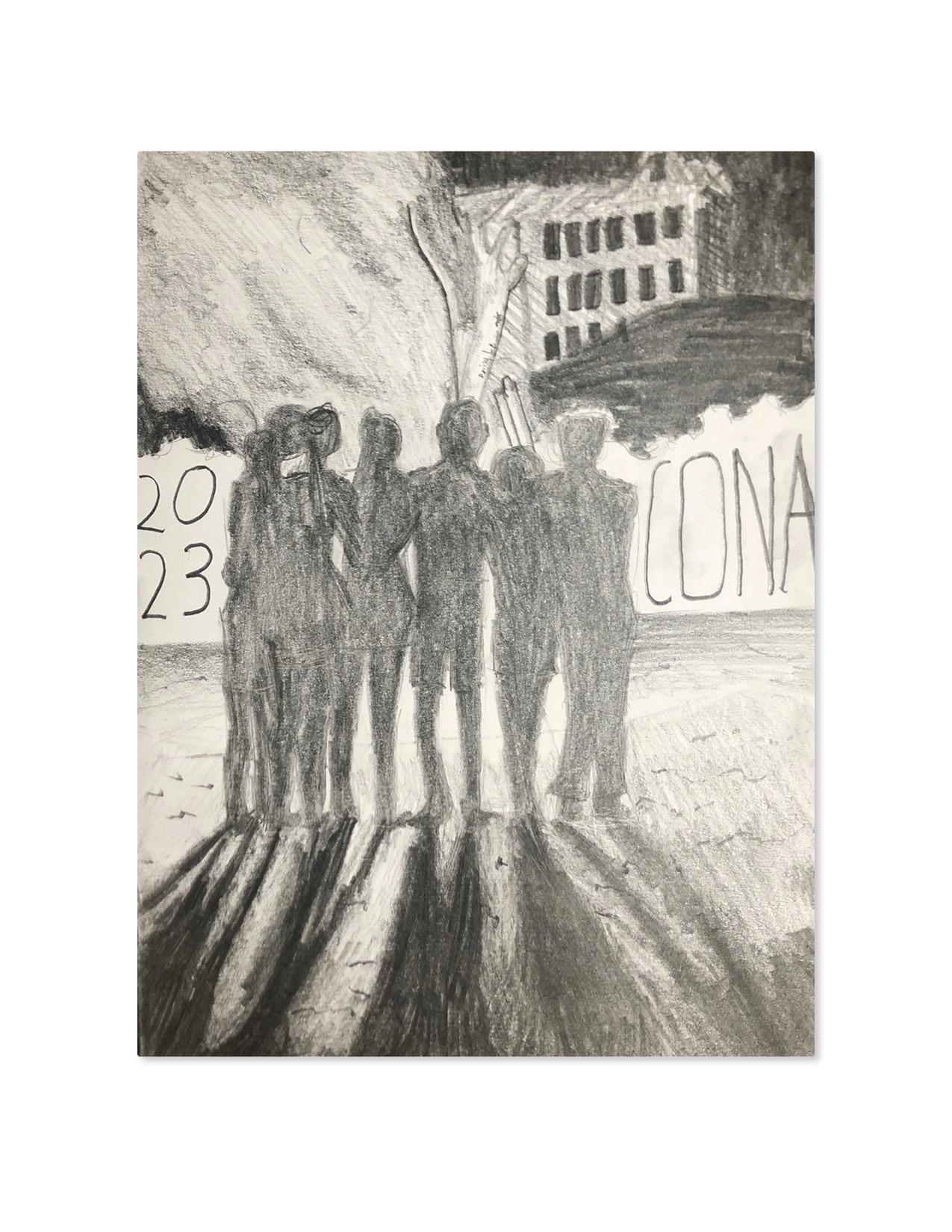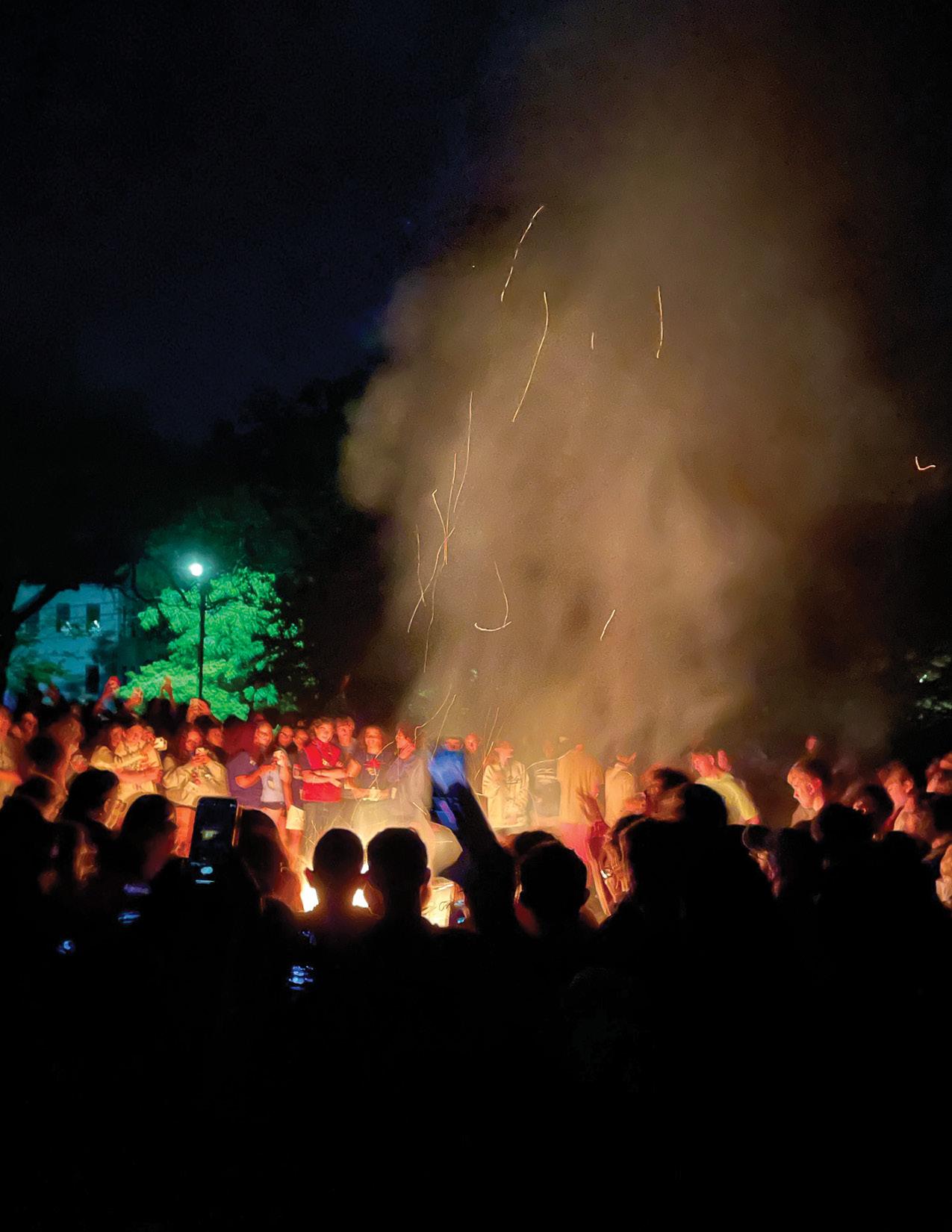
9 minute read
Cathe R ine Piot R ows K i
from The Ridge-2023
C alifo R nia
The Spirit
Advertisement
A spirit that lingers in the heat of a North Carolina July Travels from Door to Door Seat to Seat
Placard to Placard
A spirit both forcefully dynamic and timidly kind, Where armies rise and inevitably fall Where friendships form and inevitably blossom
A rare spirit
Summoned by knowledge
Charmed by inspiration
Solidified by community that special spirit forms a word that means forever that special spirit makes us feel less alone in this cruel world that lingering spirit that fades sorrows into oblivion where compromise is kryptonite where gavel taps speak, and silence where tiny, scribbled notes cards set the heart ablaze that smokey spirit, we find remnants of it left on dusty luggage on pigmented, smooth leather bus seats in the folds of rearview mirrors on the laces of our shoes to that lingering spirit: we say hello infinitely more than we say goodbye.
On the Importance of Land Acknowledgment
Land Acknowledgment: Oral or written statements used to recognize indigenous peoples as the original stewards of the lands on which a person or peoples work. Land Acknowledgements can be written at the beginning of public and private gatherings, and should be motivated by genuine respect.
This past CONA, I had the privilege of serving as the Minnesota delegation’s Conference Life Committee (CLC) Representative. As the CLC, it was my duty to gather input from my delegation to bring to the conference leadership, and to take information from that leadership back to my delegation. This two-way street is an important part of the conference, bringing youth leadership into our conference on youth voice.
Hailing from a state like Minnesota, a land steeped in the tradition of Ojibwe, Dakota, Lakota, and other native peoples, my delegation found it curious to see the memory of indigenous groups absent from conference life.
Indigenous people have an important history in the Blue Ridge area, and it’s important that the conference recognizes the tragedies that occurred in the space we use. Cherokee and Catawba tribes used to live on Black Mountain, known to them as Grey Eagle. Even as early as September 1776, these natives faced military oppression from the newly formed United states. In 1838 16,000 Cherokee were forcibly removed as a result of President Andrew Jackson’s Removal Act and continued by President Martin Van Buren’s deployment of General Winlield Scott. On May 10, 1838 the Cherokee were removed from their spiritual and native land and were forced to spend 5 months in camps where roughly 2000 - 4000 perished. Present day Cherokee live 50-60 miles away from Black Mountain on the Eastern Band of Cherokee Indian Reservation, where they hold their own sovereign government, and are 14000 tribal members strong.
This history isn’t recognized by Blue Ridge Assembly or the Mountain Manual. This certainly doesn’t mean they promote this terrible narrative, but as young people debating the future of our country, we should be certain to learn from the past.
At the conference, the CLC is directed to recommend changes to the conference for next year. A 4/5 majority of votes are required to pass recommendations. This hurdle means only 3 of 20 introduced recommendations were passed this year. One of those was a recommendation I co-authored, proposing a land acknowledgment statement be added to the “Background Of the Conference” section of the Mountain Manual on page 2, hopefully beginning a much larger collaboration between the conference, Blue Ridge Assembly, and local indigenous tribes.
Don’t take it from me, though. I don’t want to speak for Native people—I’d rather amplify their voice in my role. I reached out to a local tribe leader and friend, Dallas West, for his thoughts on the proposed change. West shared the following with me:
“This is a very challenging subject matter, but an important one. It could be considered just the tip of the iceberg in the reconciliation process that is long overdue between the Native community and the U.S. Government. From my perspective, an expanded truth and reconciliation process needs to be established between our Federal and State governments alike, in effort to heal deep wounds that have lingered from the past into the present. Land acknowledgment would be a good start to help with that healing process.
Acknowledgment of the wrongdoings by the U.S. Government in the past will help ensure it does not happen in the future. The atrocities that happened to many of the native population in the past have lingered into the present, and clear and identifiable generational trauma exists today. Moving forward with land acknowledgment will help in the healing process. But again, many Native leaders & tribal nations would argue that this is just a piece of the larger pie that needs to be examined for a comprehensive healing process.”
The CLC passed Minnesota’s recommendation with nearunanimous support. The delegates of this conference know that the time to reconcile the past is long overdue, and that we need to begin learning from our present-day tribal leaders. Public land acknowledgment in every delegate’s proposal book would be a start to this process.
However, the CLC’s recommendations are just that—recommendations. Something being passed by the Conference Life Committee does not guarantee implementation. One only has to look at last year’s trigger warning recommendation, passed again this year, to see that a recommendation is fruitless unless further argued for.
That is why I’m calling on the Conference on National Affairs leadership to take a serious look at taking a small step. A small step can begin to heal deep wounds.

The Environmental Concern

What can I do? That is the question we ask ourselves. Can an individual stop climate change and global warming, the main warning signs that Mother Earth has given us? No. No single individual can. That is our dilemma. No individual can halt the changing world, so why try? Proposed solutions to these crises in news reports are often individual-based. And while individuals can adjust their level of consumption, this ignores the fact that climate change is the result of the whole capitalistic system. The establishments that run our media pretend that no other economic system has or will ever exist, but as long as capitalism is dominating, our Earth will not get better. This crisis is a global threat and no one seems able, or willing, to deal with it.
Preserving a capitalist system that views Earth as a resource will only encourage us to see Earth as nothing more than a resource. The capitalist system that we have been living in has failed us and our Earth. As a result of the Industrial Revolution, humans have emitted 1.5 trillion tons of CO2 pollution into our atmosphere, and the numbers will continue increasing if we do not break away from the current system. People view Earth as something to exploit, to take what they want without any thoughts of repercussions. That is the capitalist mindset. Even solutions based on “sustainability” don’t measure up. Robin Kimmerer writes, “Even our definitions of sustainability revolve around trying to find the formula to ensure that we can keep on taking” (Returning the Gift, 18). Reframing the entire system is necessary, because capitalistic solutions have not and cannot slow down this crisis.
Capitalism is not morally neutral, and it never has been. Capitalism’s morals are based on money—protecting the rich,and crushing the poor. Like the socialist measures taken during the Great Depression, capitalism must be restrained when it threatens to disrupt the system it was supposedly meant to maintain.
This demands action in the form of revolution or reformation. Revolution would cause war and deaths, most likely furthering the course of global warming. At the same time, it could result in faster changes than reforms, driving large corporations out of the picture and creating a united economy where the means of production are owned by the workers. This situation would be ideal, but when has a revolution worked out the way that people thought? Reformations, although more peaceful, could take decades to create change. Either way, taking a stance against the system that has failed to help us and changing the course of history is what we must do. Do we accept that we must change as a civilization, or do we accept that humans do not have a place in Earth’s future?
The situation breaks down into individual actions in response to unrelenting capitalism by working towards a greener future. According to Kimmerer, reframing the system that we live in involves personifying the Earth. This will result in seeing the Earth as an equal, as a person, not something to exploit. We must encourage people to look at and treat Earth with respect and understanding as we would with another human being. Changing this mindset would be instrumental in changing the system itself. In order to know how to help and to make progress, education is imperative. Little things, such as recycling and sustainable shopping, can build to larger impacts, like ecologist Jean-Francois Bastin’s proposal to combat climate change by reforesting 4.7 billion acres of previously forested lands with native species on five continents. Bastin claims this action could absorb 2/3 of all the carbon emitted since the Industrial Revolution. If we strategize carefully, we can reset the path our civilization has been destroying.
No solution will go through smoothly or efficiently. Any answer will disrupt the system, but we must combat these crises now. Our Earth is getting warmer, ecosystems are being destroyed, and animal species are going extinct. If we sit and do nothing, the answers will only become harder in the future. The power comes from the people, so why don’t we act?


Post-Conference Depression
Post-Conference Depression, otherwise known as PCD, is a chronic illness affecting hundreds of attendees each and every year. As I sat in the car, ready to go home, my dad turned to me and asked, “How was the trip?”. Tears began formulating in my eyes. How could I explain a trip of 7 days, 168 hours, and 10080 minutes in a single paragraph, sentence, or word? I turned to him to respond. “Where do I even start?”
I was one step into Texas when I started developing the associated symptoms of PCD—craving Cheerwine and Eureka Treats, missing my friends, and going through photos with “Good Ol’ Days” and “Take Me Home, Country Roads” playing in the background. This past week was filled with tears, laughter, screams, and every emotion I could think of. I’m so grateful for my CONA family and all the friendships I have made on the mountain over this past week. You simply just had to be there to understand the hype.
In the middle of the night, we drove through the gates of Blue Ridge Assembly. We had finally reached light. There it was.
Eureka.

In that moment, I felt alive.
From the very first time I stepped foot onto the mountain, I felt home. Despite not knowing what the next 7 days would look like, I knew that CONA would be a safe space.
Over the next 7 days, I created forever bonds with passionate and remarkable delegates from across the nation, enjoyed countless Eureka treats, debated consistently, learned new and important issues that were nationally and even globally important, chanted at the top of my lungs before the sun was up, and felt every emotion that a human could experience. For me, the past week on the mountain was an opportunity for growth—challenging myself to become better and surrounding myself with peers who were looking for the exact same thing. I lived so in the moment this week that when the end came, it didn’t feel real. I genuinely thought PCD (Post-CONA depression) wouldn’t reach my doorstep, but once I got off the plane, grabbed my luggage, and walked out of the airport, my entire body went cold. The next and only emotion that came (and the only emotion that stayed with me for days following) was sadness, bringing uncontrollable tears that rushed down my cheeks.
After experiencing a week as good as this one, how could one not experience PCD? I wear it as a badge of honor. Because, when I reflect on the memories I gained at CONA, I will remember the people and the experiences, but most of all, I’ll remember being and feeling alive.

Joyrider

I think of a teenage June, of sitting in the back right seat of your dad’s convertible, of the Beamer, of stopping to fill up the front left tire with air which I think you could have even blown up yourself, like a balloon, if it weren’t for the smoke at the roof of your mouth that I know is fresh no matter how slick your denial sounds.
I think of the fact that the entire world doesn’t know I’m in another city, cramped in the back seat, trying not to crack the leather upholstery like the thick stained glass of the church I watched you lose yourself inside of, a maze of blood in bottles of wine and reminders of our easy mortality, of something beige.
I think of fixing you, of taking nails and a hammer to your instincts, of polishing your jaw and veins until you are something as shiny and expensive as the car we’re in, until you are a God pressing the pedals, until you choose the ugliness, the unholiness in loving from the back seat, in crawling into the cracks in the leather and being part of this—part of the looping backroads, labyrinth corridors of this memory.


